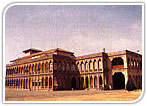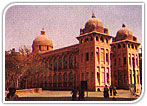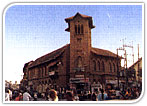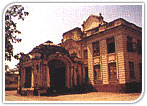| "Cultural Capital of Saurashtra" |
 Bhavnagar
was founded by Bhavsinhji Gohil (1703-64 AD) in 1723 AD near the Gulf of
Khambhat, on a carefully chosen strategic location having potential of
maritime trade. Till independence, Bhavnagar State was ruled by the Gohil
Rajput clan.
Bhavnagar
was founded by Bhavsinhji Gohil (1703-64 AD) in 1723 AD near the Gulf of
Khambhat, on a carefully chosen strategic location having potential of
maritime trade. Till independence, Bhavnagar State was ruled by the Gohil
Rajput clan. Present
day bhavnagarm owes much to the vision of the past ruler Sir Takhtsinhji
Gohil (1869-96 AD). The town planning schemes were designed and
implemented under the guidance of progressive rulers of Bhavnagar. During
the reign of Sir Takhtsinhji, the British State Engineer Proctor Sims
supervised the construction of Barton Library, High Court, Alfred High
School and Sir Takhtsinhji Hospital.
Present
day bhavnagarm owes much to the vision of the past ruler Sir Takhtsinhji
Gohil (1869-96 AD). The town planning schemes were designed and
implemented under the guidance of progressive rulers of Bhavnagar. During
the reign of Sir Takhtsinhji, the British State Engineer Proctor Sims
supervised the construction of Barton Library, High Court, Alfred High
School and Sir Takhtsinhji Hospital. Nilambag Palace, now a heritage hotel, is a magnificant building set
amidist a huge estate of 10 acres. It was designed by a German architect,
as a royal residence in 1859 AD. It combines elements of Indian
architecture with a modern outlook.
Nilambag Palace, now a heritage hotel, is a magnificant building set
amidist a huge estate of 10 acres. It was designed by a German architect,
as a royal residence in 1859 AD. It combines elements of Indian
architecture with a modern outlook. Excurtions:
Excurtions: